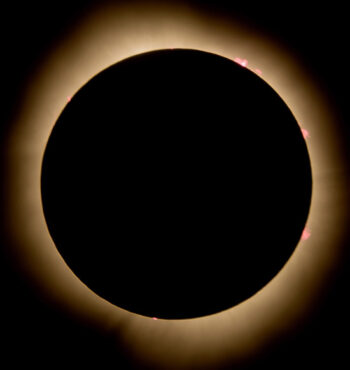Eclipse watchers came early, stayed late
VW independent staff/submitted information
COLUMBUS — The message from state officials was clear: Come early, stay late for last week’s solar eclipse. New data shows that most people did just that, avoiding the post-eclipse gridlock other states experienced.
Travel data from the Ohio Department of Transportation shows traffic volumes were up 12.8 percent on Sunday, fell by 4.4 percent the day of the eclipse, and increased again by 15.8 percent on Tuesday.

The biggest increase in traffic on Monday came on Ohio 31 north of Marysville where traffic was up by 71.7 percent, U.S. 35 west of Chillicothe with a 67.4 percent increase in traffic, and Ohio 14 west of Ohio 165 to the Pennsylvania border saw a 42.8 percent increase.
According to ODOT, within the path of totality, traffic on U.S. 30 from Van Wert to Canton was up 13 percent, including a 53.4 percent increase west of U.S. 224 near Van Wert. Traffic on U.S. 23 between Chillicothe and Marion was up 11.5 percent with the biggest jump around Marion where traffic increased by 21.4 percent.
Other ODOT data shows the state’s interstates also saw increased traffic. I-71 north of U.S. 30 saw a 21.5 percent bump in traffic volume, I-75 in Perrysburg was up 22.6 percent, and I-70 saw a 15.7 percent increase between I-270 and U.S. 42. Traffic on I-74 between Cincinnati and Indiana saw traffic surge by 14.8 percent.
On Tuesday, the entire I-70 corridor saw an 11.8 percent increase in traffic, the biggest bump in the Cambridge area where traffic volumes were up by more than 20 percent. Traffic on I-77 was up 11.1 percent, including a 20 percent increase in traffic south of Canton.
For a relatively short amount time on Tuesday, after the eclipse, Van Wert County traffic was reported to be at a standstill on U.S. 30 from Richey Road all the way to Fort Wayne.
“This data shows that Ohioans and visitors did what we asked of them, and it worked to prevent a huge surge of traffic directly following the eclipse,” ODOT Director Jack Marchbanks said. “I also commend our crews for their efforts ahead of, during, and after the eclipse. It really paid off.”
The data comes from more than 200 continuous traffic count stations across the state. Data was compared to the average traffic volumes observed on Sundays, Mondays, and Tuesdays in April 2023.
Traffic volume across the Ohio Turnpike – a 241-mile toll road designated as Interstate 80, I-90 and I-76 – increased during the days leading up to, during, and after the total solar eclipse on April 8.
The highest traffic volume increases on the Ohio Turnpike occurred on Monday, April 8, with 156,812 trips and Tuesday, April 9, with 162,381 trips. The Ohio Turnpike averages about 139,000 trips per day.
“I commend our staff and troopers from the Ohio State Highway Patrol for their meticulous planning in preparation of the solar eclipse,” said Ferzan M. Ahmed, P.E., executive director of the Ohio Turnpike and Infrastructure Commission in Berea. “As expected, there were traffic backups, especially eastbound, as travelers were returning home. The unusually heavy traffic was managed safely and as well as can be expected. Message boards were used to prevent motorists from stopping on the shoulders and to slow down and to expect stopped traffic.”
To accommodate the influx of travelers into the state, the Ohio Turnpike’s service plazas and participating vendors increased their hours of operation. Gasoline and diesel fuel inventories were increased.
“Many travelers indicated they chose the Ohio Turnpike’s 14 service plazas as their viewing destinations for eclipse because of ample parking, restaurant choices, and restrooms,” Ahmed stated. “The parking lots were full. Our customers were all safely situated at the various service plazas to view the eclipse.”
During the solar eclipse, the Ohio State Highway Patrol heightened its operations to safeguard both Ohioans and visitors. From Friday, April 5, through Tuesday, April 9, troopers conducted 16,285 traffic stops, marking a 27 percent increase from the same time frame the prior week. Additionally, troopers assisted 2,066 motorists by helping change tires, providing directions, and aiding motorists out of gas. Despite the increase in motorists on Ohio roads, provisional data shows that troopers also saw a six percent decrease in the number of crashes investigated compared to the same time frame the prior week thanks to the collaborative efforts of everyone involved.
“The success of this event was made possible not only by the dedicated efforts of our Patrol personnel and fellow safety service partners but also by the responsible actions of the motoring public,” said Colonel Charles A. Jones, Patrol Superintendent. “Together, we ensured a safe and memorable experience for all.”
The Patrol took a proactive approach to manage the increased traffic volume during the solar eclipse. These measures included increased staffing, strategic utilization of the Patrol’s Aviation Section, and close collaboration with state and local partners.
POSTED: 04/17/24 at 3:43 am. FILED UNDER: News







